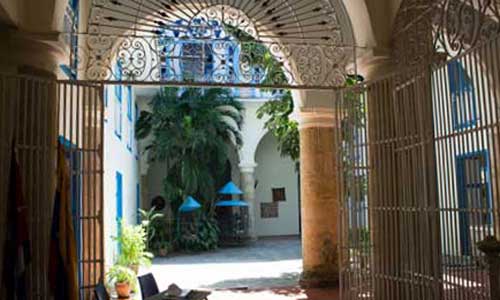The Casa Museo Simón Bolívar, a colonial mansion located in the Historic Center of Havana, at Mercaderes #156, entre Obra Pía y Lamparilla, offers interesting details about the life and legacy of the Liberator.
Built between 1806 and 1817, its architecture corresponds to the neoclassical style that prevailed in Havana in the first half of the 19th century and was owned by the Marquises of Aguas Claras and the Counts of Villanueva.
During the Republican era, it served as the consulate of Sweden and Brazil. Later, however, it became a citadel, which, after the revolutionary triumph, housed a total of 24 families.
Deterioration and time took their toll on the building, but the Havana City Historian’s Office, under the direction of Dr. Eusebio Leal Spengler, made every effort to restore it to its full splendor and create a museum there to spread the life of this distinguished Latin American independence fighter.
Also involved in the genesis of the Casa Museo Simón Bolívar in Havana on the Venezuelan side were the widow of the popular writer Otero de Silva, María Teresa Castillo, and the then ambassador of the South American nation in the largest archipelago of the Antilles, María Clemencia López Jiménez.
These efforts bore fruit with the inauguration of this institution on 24 July 1993, a space that pays well-deserved homage to Bolívar's life and work, as well as to Venezuelan culture and that of other regions of Latin America.
Among the main permanent exhibition rooms are the Bolivarian Epics and the Bolívar Humanized. The latter is one of the most important, as it is the mother collection of the house, the fruit of the artistic legacy of Glenda Mendoza, winner of the Popular Prize for Plastic Arts in Venezuela. There you will appreciate how the life of the Liberator is narrated, in polychromatic clay, from a very human, original, and attractive perspective.
Visitors can see objects related to the Bolivarian Epics. But one of the most relevant is, without a doubt, the facsimile of the Letter of Jamaica written in 1815 by Simón Bolívar. This document was lost for 200 years.
The copy of the Liberator's testament, medals, decorations, and a replica of the sword given by Peru to Bolivar in 1825, is also striking. In the museum, you will be able to see a small sample of the martyr's hair, a gift from the Fundación Casa Simón Bolívar in Venezuela.
A room dedicated to Manuela Saenz, Bolivar's heroine and lover, was recently inaugurated in coordination with the Ecuadorian embassy in Cuba and is located on the first floor. The room evokes the different stages of Manuela's life: her early involvement in just causes, her years of romance with the Liberator Simón Bolívar, and her last days of life.
In addition to two paintings by the Ecuadorian artist Pilar Bustos, who studied in Cuba during her youth, there is also a reproduction donated by the National Academy of History of Ecuador of the large painting that heads the executive room of the academy, in which Manuela Sáenz and Simón Bolívar appear in a posture that engages in dialogue with the spectator.
The Casa Museo Simón Bolívar in Havana also treasures other valuable works donated by Venezuelan and Cuban artists, which complete the museum's collections. In addition, there are exhibitions on the culture of other Latin American countries, as well as archaeological finds from the restoration of the building during the creation of the museum.
It is very interesting for bibliophiles and those interested in the subject to know that this center holds approximately 10,000 copies related to the Liberator and Venezuela in its Simón Rodríguez library, named after Bolívar's teacher.


Deje un comentario